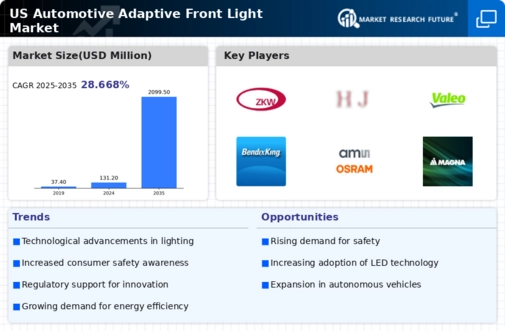Rising Safety Standards
The automotive adaptive-front-light market is experiencing growth due to increasing safety standards mandated by regulatory bodies. In the US, the National Highway Traffic Safety Administration (NHTSA) has been advocating for enhanced vehicle safety features, which include advanced lighting systems. These systems improve visibility during adverse weather conditions and at night, potentially reducing accident rates. As a result, manufacturers are investing in adaptive front lighting technologies to comply with these regulations. The market is projected to grow at a CAGR of approximately 8% over the next five years, driven by the need for safer vehicles. This trend indicates a strong alignment between regulatory requirements and consumer safety expectations, further propelling the automotive adaptive-front-light market forward.
Environmental Considerations
Environmental concerns are becoming a pivotal factor influencing the automotive adaptive-front-light market. With a heightened focus on sustainability, manufacturers are increasingly adopting energy-efficient lighting technologies, such as LED systems, which consume less power and have a longer lifespan compared to traditional halogen bulbs. The US government has been promoting energy-efficient technologies through various initiatives, which encourages automakers to invest in adaptive lighting solutions that align with these goals. As a result, the automotive adaptive-front-light market is expected to see a surge in demand for eco-friendly lighting options, potentially leading to a market growth of 10% by 2027. This shift not only addresses environmental issues but also appeals to the growing segment of eco-conscious consumers.
Increased Vehicle Production
The automotive adaptive-front-light market is poised for growth due to the overall increase in vehicle production in the US. As manufacturers ramp up production to meet rising consumer demand, there is a corresponding need for advanced lighting systems that enhance vehicle safety and aesthetics. The automotive industry in the US is projected to produce over 15 million vehicles annually by 2026, with a significant portion incorporating adaptive front lighting technologies. This trend indicates a robust market opportunity for suppliers and manufacturers of adaptive lighting systems. The anticipated growth in vehicle production is likely to drive a 12% increase in the automotive adaptive-front-light market, as automakers seek to differentiate their products through innovative lighting solutions.
Consumer Demand for Customization
Consumer preferences are shifting towards personalized vehicle features, which is significantly impacting the automotive adaptive-front-light market. As buyers increasingly seek unique and customizable options, manufacturers are responding by offering adaptive lighting systems that can be tailored to individual preferences. This trend is particularly evident in the luxury vehicle segment, where high-end models often include advanced lighting technologies as standard features. Market analysis suggests that the demand for customizable lighting solutions could lead to a 15% increase in sales within this segment over the next few years. This growing inclination towards personalization is likely to drive innovation and competition within the automotive adaptive-front-light market.
Technological Integration in Vehicles
Advanced technologies in vehicles are a key driver for the automotive adaptive-front-light market. Innovations such as LED and laser lighting systems are becoming increasingly prevalent, offering superior illumination and energy efficiency. The US automotive industry is witnessing a shift towards smart lighting solutions that adapt to driving conditions, enhancing both safety and comfort. According to industry reports, the market for adaptive lighting systems is expected to reach $2 billion by 2026, reflecting a growing consumer demand for high-tech features. This technological evolution not only improves the driving experience but also aligns with the automotive industry's broader trend towards automation and connectivity, thereby fostering growth in the automotive adaptive-front-light market.





















Leave a Comment